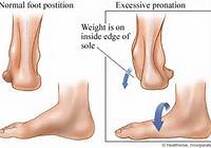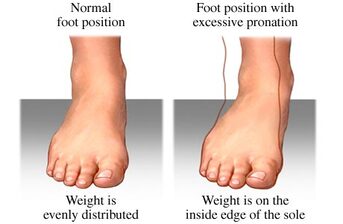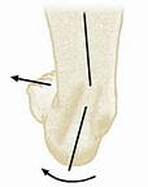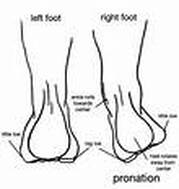Ankle Pronation: Effects in SkatingBy Susan Ellis, May 2013
|
You can't just sit there and wait for people to give you that golden dream. You've got to get out there and make it happen yourself. ~ Diana Ross |
Pronation is a turning outward of the foot at the ankle, so that one has a tendency to walk on the inner border of the foot. When this occurs to a great extent it is termed over-pronation.
Pronation can be hereditary from our parents or congenital, meaning the way we were positioned in the uterus.
You can test for pronation by looking at the leg and foot from the back. Normally you can see the Achilles Tendon run straight down the leg into the heel. On an over-pronated foot the tendon veers outward at the heel making the inner ankle bone much more prominent than the outer ankle bone.

Because pronation is a twisting of the foot, all of the muscles and tendons that run from the leg and ankle into the foot will be twisted. If left untreated the muscles, ligaments, and other soft tissue structures that hold the bones together at the joints become looser than normal and may cause fallen and painful arches, shin splints, Achilles Tendonitis, generalized tendonitis, plantar fasciitis, pain in the ball of the foot, heel spurs, hammertoes, fatigue, muscle aches and pains, cramps, frequent ankle sprains, knee pain, hip pain, lower back pain, and reduced muscle efficiency (endurance and strength).
Over-pronation can greatly impact our skating in two ways – physical training and technical skill.
Over-pronation can greatly impact our skating in two ways – physical training and technical skill.
Physical training:
Given the host of potential for injuries and loss of muscle efficiency in training as listed above, it is pretty obvious why proper and early treatment is important.
If pronation is diagnosed very early, there is a chance it can be corrected. Treatment may include night braces, exercises or custom made orthotics to help keep the tendons, ligaments and joints aligned. Too often doctors will chock up complaints of pain in children and adolescents to ‘growing pain’ rather than looking at what might be causing the pain. If they wait too long the window of opportunity to improve alignment closes and then the only option is orthotics. Since off-ice skating training involves lots of running, jumping, weight training, dryland imitations, all things that place a great amount of pressure and strain on the legs, ankles, and feet, it is imperative to prevent injuries to be able to keep training and skating.
Technique:
Pressure in to the ice is a key to efficient and powerful pushes. The goal in the push is to keep the pressure in to the ice through the outside part of the foot all the way through the push. Skaters with over-pronation have difficulty even landing on the outside edge let alone keeping pressure on the outside part of the foot because as soon as the foot comes through to set down it rotates outward already.
Getting pressure to the outside is an exercise in frustration if the foot alignment will not allow it in the first place. Keeping pressure there once the arch suppresses and the ankle collapses in further takes pressure and power away from the push.
A custom orthotic can help prevent the arch from collapsing and help to keep alignment and pressure in the right place on the blade. Some skaters have the boot custom made to support the arch, but many skaters don’t have room in their current boot for an orthotic. I have made arch supports for skaters using many materials and the one I found best is to cut down and mold a beach sandal to fit under the arch.
Given the host of potential for injuries and loss of muscle efficiency in training as listed above, it is pretty obvious why proper and early treatment is important.
If pronation is diagnosed very early, there is a chance it can be corrected. Treatment may include night braces, exercises or custom made orthotics to help keep the tendons, ligaments and joints aligned. Too often doctors will chock up complaints of pain in children and adolescents to ‘growing pain’ rather than looking at what might be causing the pain. If they wait too long the window of opportunity to improve alignment closes and then the only option is orthotics. Since off-ice skating training involves lots of running, jumping, weight training, dryland imitations, all things that place a great amount of pressure and strain on the legs, ankles, and feet, it is imperative to prevent injuries to be able to keep training and skating.
Technique:
Pressure in to the ice is a key to efficient and powerful pushes. The goal in the push is to keep the pressure in to the ice through the outside part of the foot all the way through the push. Skaters with over-pronation have difficulty even landing on the outside edge let alone keeping pressure on the outside part of the foot because as soon as the foot comes through to set down it rotates outward already.
Getting pressure to the outside is an exercise in frustration if the foot alignment will not allow it in the first place. Keeping pressure there once the arch suppresses and the ankle collapses in further takes pressure and power away from the push.
A custom orthotic can help prevent the arch from collapsing and help to keep alignment and pressure in the right place on the blade. Some skaters have the boot custom made to support the arch, but many skaters don’t have room in their current boot for an orthotic. I have made arch supports for skaters using many materials and the one I found best is to cut down and mold a beach sandal to fit under the arch.

Then I just used a bench grinder to start whittling it down to fit under the skaters arch while they are standing barefoot. Be careful to whittle only a small amount at a time. If you take too much off the arch will still collapse and the foot won’t align properly. Keep having the skater stand on the arch as you whittle it down to check the alignment of the foot. Once you have it whittled into alignment, try it with the skates on, lightly taping the arch support to the foot. You might have to whittle some more to get the foot in the skate with the arch in place. You are looking for a straight line from the upper part of the Achilles straight down through the skate blade to the floor, with no tilt of the heel or roll of the ankle. The arch support may hurt a lot at first but they do get used to it and the improvement in alignment and pressure in to the ice is very much worth it.
Another way to build an arch is by applying layers of duct tape down over the existing arch of the boot and gradually build the layers up until you have the alignment you need.
If either of these solutions work you should consider getting a custom boot with the arch molded to properly align your leg, ankle, and foot.
Some people advocate putting a shim under the blade to change the angle of the blade vs the heel. I would only use this as a last resort if the orthotic method doesn't work. Using the shim doesn't address the problem of the collapsed arch, and if the arch is still collapsing you are still missing pressure in to the ice through the use of all muscle groups from the foot all the way up the leg.
Some skaters have also tried moving the blade way over on the boot. While this may solve the problem of the boot not hitting the ice on one side, when you lean it is more likely then to hit on the other side. And again it doesn't address the collapsed arch issue.
Sources:
http://en.wikipedia.org/wiki/Pronation_of_the_foot
http://www.ourhealthnetwork.com/conditions/FootandAnkle/Pronation.asp
Exercises for pronation:
http://www.livestrong.com/article/212950-overpronation-exercises/
Another way to build an arch is by applying layers of duct tape down over the existing arch of the boot and gradually build the layers up until you have the alignment you need.
If either of these solutions work you should consider getting a custom boot with the arch molded to properly align your leg, ankle, and foot.
Some people advocate putting a shim under the blade to change the angle of the blade vs the heel. I would only use this as a last resort if the orthotic method doesn't work. Using the shim doesn't address the problem of the collapsed arch, and if the arch is still collapsing you are still missing pressure in to the ice through the use of all muscle groups from the foot all the way up the leg.
Some skaters have also tried moving the blade way over on the boot. While this may solve the problem of the boot not hitting the ice on one side, when you lean it is more likely then to hit on the other side. And again it doesn't address the collapsed arch issue.
Sources:
http://en.wikipedia.org/wiki/Pronation_of_the_foot
http://www.ourhealthnetwork.com/conditions/FootandAnkle/Pronation.asp
Exercises for pronation:
http://www.livestrong.com/article/212950-overpronation-exercises/





